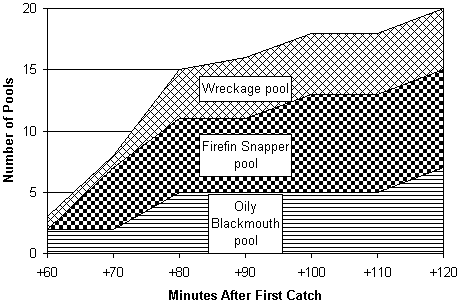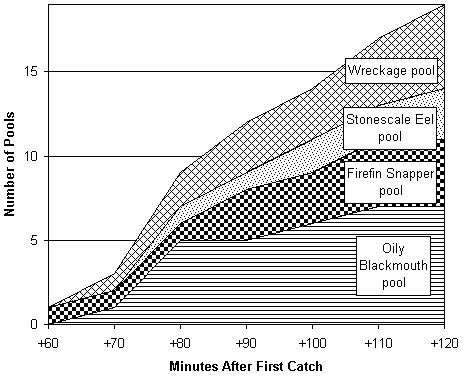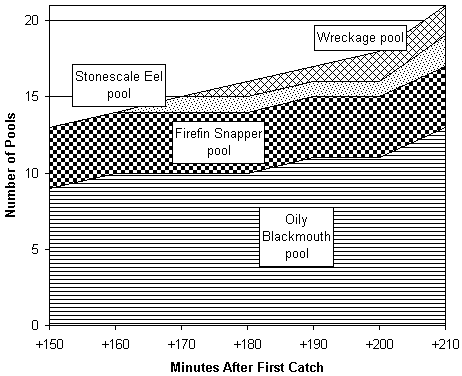This topic examines how pools (schools) of fish appear, and suggests some basic rules and timings. On this page:
- A Simple Approach
- Hillsbrad Foothills
- Feralas
- Cherry Picking
- Rules are There to be Broken
- Alternative Theories
- Postscript: Outland
- Further Reading
A Simple Approach
The simplest way to determine how pools of fish appear is to fish all the existing pools and then wait for new ones to appear. Initially every pool in the coastal part of a zone is fished. Then, every ten minutes, one rides up or down the coast recording (but not fishing) the types of pool found.
Although inherently simple, this method is easily undermined by other people fishing. This has been controlled by:
- Fishing at quiet times of day, typically mid-morning.
- Forming a mental map of the pools found on each ride, so that if any existing pool has been fished, it will be obvious.
- Abandoning attempts once other fishermen or women are spotted in the area.
- ((And fishing on a relatively new, low-population realm, where most people lack the skill to fish.))
Two locations were tested, each selected for the ease of riding a route that checked all possible pool "spawning" locations:
- Hillsbrad Foothills - Eastern Strand, Southshore and Western Strand.
- Feralas - Forgotten Coast.
Both contain an almost identical number of possible pool locations. The skill requirement and type of pools varies.
Hillsbrad Foothills
Although a popular zone, hostile creatures along the coast and a equal number of Horde and Alliance, makes the area rather dangerous for casual fishermen and women. The most frequently fished pools are those that appear in Southshore itself. Some pools can go untouched for hours at a time.
It took just under 60 minutes to fish the 23 pools found on the initial run along the coast:
- 5 Firefin Snapper pools
- 14 Oily Blackmouth pools
- 4 Wreckage pools.
Then every ten minutes, the number and type of pools found along the coast were recorded (but not fished). These pools are shown in the graph below. Each pool type is shown as a shaded block. The blocks stack to show the total number of pools. Time is shown from left to right.

The most important finding is that the number of pools is not constant. In 60 minutes during the initial fishing, the number of pools reduced from over twenty to just three. In the 20 minutes after the initial catches were made (60-80 minutes after the first catch) a rapid increase can be seen in the number of pools to 15, then slower growth to 20 pools within an hour. The proportion of each of the three pool types is much more even than before, with no bias towards Oily Blackmouth pools.
Two patterns were observed that are not clear from the graph:
- The first pools to appear were all in the part of the coast that had been fished first. It is possible that pools do not reappear until about 60 minutes after being fished.
- Once pools have appeared, they remain until fished. They do not change over time unless fished.
Of course this is just one trial in a process with a lot of variation. Let's move on to Feralas.
Feralas
Feralas is a quiet zone. The appearance of Stonescale Eel pools and high-value wreckage tends to attract fishing activity. The pools are patrolled by a variety of Elementals and Giants, making the area difficult for less experienced individuals.
It took just under 60 minutes to fish the 23 pools found on the initial run along the coast:
- 17 Firefin Snapper pools
- 5 Oily Blackmouth pools
- 1 Wreckage pools.
No Stonescale Eel pools were found, in spite of this type of pool often appearing in the area.
As before, every ten minutes the number and type of pools found along the coast were recorded (but not fished). These are shown in the graph below.

The patterns are quite similar to those in the Hillsbrad Foothills. There is a fairly rapid increase for twenty minutes after the initial catches. This is followed by a slightly slower increase for the rest of the hour. The rate of pool re-appearance in Feralas is slightly slower than in the Hillsbrad Foothills.
There is a very dramatic reduction in the number of pools following initial fishing, this time from over twenty to just one. Although there is a slight bias towards Oily Blackmouth pools, biases are not as extreme as at the outset (17 Firefin Snapper pools with no Stonescale Eel pools).
In both Feralas and Hillsbrad there is one curiosity: The balance of different pool types after our test is far more even than before the test. The reason is "cherry picking".
Cherry Picking
Cherry picking involves fishing just one or two types of pool, and leaving all the others. It is common because most people have no use for Oily Blackmouth or Firefin Snapper, preferring to fish wreckage or Stonescale Eel pools.
To examine how this affects the appearance of pools, I have continued the previous Feralas test. All the Stonescale Eel and wreckage pools were fished, leaving the Oily Blackmouth or Firefin Snapper pools untouched.
Over 30 minutes, ten pools were fished: 3 Stonescale Eel pools and 7 wreckage pools. Then every ten minutes runs were made along the coast, recording (but not fishing) the pools found. The results are shown in the graph below. Timings are from the first catch in the initial Feralas test above.

Pools continue to appear gradually over time, but the new pools are not restricted to the two types that were fished. Instead, any type of pool may appear. So, the result of cherry picking is that fewer and fewer Stonescale Eel and wreckage pools appear in the area. This explains why, when we first arrived in Feralas, we couldn't find any Stonescale Eel pools at all: They had been cherry-picked out of existence, and nobody was fishing Oily Blackmouth or Firefin Snapper pools to compensate.
Compare this test to the previous test. The rate at which pools reappear is slower when only half have been fished, than when all have been fished. It seems that the rate of re-appearance changes depending on how many pools already exist.
Rules are There to be Broken
Unfortunately, the concepts described above cannot be applied to all pools.
For example, certain Sagefish pools behave quite differently. In Mirkfallon Lake, in the Stonetalon Mountains, there always seem to be two Sagefish pools in an area. Sometimes instead of a Sagefish pool, a wreckage pool, but (in my experience) not more or less than two pools. Fishing one pool to extinction merely creates a replacement pool somewhere else in the lake.
A similar pattern seems to apply to Ashenvale - but with a twist. The possible pool locations are split between various different lakes in Ashenvale, including the lake at Astranaar and Mystral Lake (near the Stonetalon tunnel). For example, there may be one pool in each lake, or two in one and none in the other. Since the lakes are several minutes walk apart, this can be dreadfully confusing for anyone trying to fish just one lake.
However more than two Sagefish pools can be found in inland areas of the Hillsbrad Foothills, so such a simple pattern cannot be applied there.
Another unproven theory I call "there is always one": In any area there will always be at least one pool at any one time. This should be easy to test in Faldir's Cove, in the Arathi Highlands. Here there are only five or six possible pool locations, all very close to one another. For the first six pools, each pooled I fished out was immediately replaced by another pool at a different location in the cove. Unfortunately after six, I couldn't find a seventh pool: So either the theory is wrong, and eventually it is possible for no pools to exist, or I simply missed a possible pool spawning location.
Alternative Theories
I have credited a theory called "double pools" to Mizzy. There is a rare chance that a new pool will appear directly under the one that you are fishing. This can result in far more fish than normal from one pool, or a pool that changes type while you are fishing from it. I recall Mizzy originally stated that this applied to any catch over four, and therefore in extreme cases (12 catches from the "same" pool), "triple pools" were possible. However, I am sure six catches is the maximum for all normal pool types except Sagefish ((the official documentation says "4-6")). This makes these double pools somewhat less common. Personally I've only experienced double pools in Stranglethorn Vale. They may be more common there due to the zone's popularity for pool fishing, or the fact the zone has more pools than any other.
Charming writes: "Not all the nodes are active at all times of day. For instance, one node may be active during the 12pm/6am period, but NOT the next timeframe. I have noticed that certain times of the day it appears that more or less nodes are active." I don't have any evidence to support this. It is quite an attractive theory, since it matches how catches from open-water fishing vary by time of day (see the Variation by Time topic). Unfortunately there is a much easier explanation for seeing different patterns of "nodes" at different times of day: People are more likely to fish at certain times of day.
Postscript: Outland
In Outland ((available with The Burning Crusade expansion)) pools are the prime source for all useful fish. I have spent a long time fishing these pools: You can read further details in The Burning Crusade, Catching Furious Crawdad and Mr. Pinchy, and Fishing Pure Water topics.
Extensive experimentation, particularly with Highland Mixed Schools, established three core principles:
- There are a fixed number of pool spawning locations in the set, any of which may spawn.
- Each pool will typically respawn 60-65 minutes after it was last being fished (emptied). It is very unlikely to respawn in less than 40 minutes, but will sometimes take as long as 90 minutes.
- There is a maximum number of pools that will be visible at one time across the set, regardless of time since last catch. This is typically between 30-50% of the all possible pool spawning locations.
The first rule probably applies everywhere, however it is possible that in some zones there are several sets of pools (not just a separate set for iland and coastal areas). Identifying sets is not terribly easy.
The second rule probably applies selectively: In some zones I believe the minimum respawn time is zero - typically low-level areas, such as Schools of Deviate Fish in the Barrens, and Sagefish. In most zones the "about an hour" value will apply.
With those two caveats, the three core principles seem to be able to explain all pool appearances.
Further Reading
- Pools and Wreckage - This chapter introduces pools and wreckage.
- Fishing Elemental Water - Discusses the appearance of Patches of Elemental Water, found in Azshara.
- Catching Furious Crawdad and Mr. Pinchy - Discusses the appearance of Highland Mixed Schools (The Burning Crusade only).